Relocating to a new duty station as a military member comes with its own unique set of challenges. One of the biggest tasks is preparing your personal vehicle for the big move. Whether shipping it cross-country or driving it yourself, there are important steps to take to ensure a smooth transition.
Deciding How to Move Your Vehicle
The first major decision is how you want to move your vehicle – shipping or driving. Both options have pros and cons to consider:
Shipping Your Vehicle
- Pros:
- Eliminates long drive and stress of navigating unfamiliar roads.
- Allows you to fly instead and avoid adding miles to your vehicle.
- Safer option if moving during hazardous weather periods.
- Cons:
- Typically more expensive than driving yourself, ranging from $500-$2000 depending on distance.
- Higher risk of damage in transit compared to self-transporting.
- Less control over delivery timeline and drop-off location.
Driving Your Vehicle
- Pros:
- Completely free compared to shipping costs.
- Retain full control and can stop along the way for sightseeing.
- Lower risk of vehicle damage during the move.
- Cons:
- Long road trip adds wear and tear as well as fuel costs.
- More stressful navigating alone with all belongings.
- Safety risks like fatigue, weather, vehicle issues during trip.
For most military members, the added costs of shipping usually means driving is the better financial option if you’re comfortable with a road trip. But shipping may be preferable for very long distances, hazardous weather windows or vehicle transport limitations.
Prepping Your Vehicle for Shipping or Driving
Regardless of your chosen mode of transport, there are important prep steps to take care of on your vehicle:
Maintenance and Safety Checks
Schedule a full inspection with your mechanic 2-4 weeks before your move date to check:
- Tires – Replace if bald or irregular wear is present.
- Brake pads/rotors – Replace heavily worn parts.
- Fluids – Top off engine oil, brake fluid, transmission fluid, coolant, power steering fluid.
- Hoses/belts – Inspect for cracks and replace as needed.
- Battery – Test charge level and replace if weak.
- Lights – Ensure all exterior lights are functional.
- Maintenance items – Change oil/filters and address other scheduled maintenance.
A well-maintained vehicle in good repair will avoid breakdowns en route or denied transport.
Vehicle Prep
- Wash/wax exterior to protect the paint from elements.
- Clean interior thoroughly, especially carpets and upholstery.
- Fix any dents, scratches or rust before transit.
- Remove all personal items from interior/trunk before shipping.
- Deflate spare tire for shipping to prevent damage.
- Address any recalls or technical service bulletins on your vehicle.
Proper cleaning and vehicle prep ensures arrival at your destination looking showroom fresh!
Paperwork Prep
- Title, registration and insurance documentation must match orders.
- Update insurance policy with shipping/driving plans and new address.
- Obtain shipping estimates and schedule transport date if shipping.
- Pack orders, PCS paperwork and travel itinerary together.
- Complete weight tickets and vehicle condition reports if shipping.
Having paperwork in order allows a smooth vehicle check-in and registration at your new home station.
Logistics of Shipping or Self-Transport
Once vehicle prep is complete, the execution of moving it requires attention to logistics:
Shipping Logistics
If shipping, important steps include:
- Schedule pickup 2-3 days before moving out of old residence.
- Load vehicle onto transport carrier – van, flatbed or enclosed trailer.
- Secure all vehicle openings and glass with protective wrap.
- Sign delivery paperwork and tracking documentation.
- Track shipment online and plan for estimated delivery date.
- Inspect vehicle condition upon receipt and note any issues.
Move Your Vehicle – Self-Transport Logistics
If driving, some factors to consider are:
- Plan route in advance factoring distances, scenery and fuel stops.
- Load packed belongings in vehicle securely and evenly distributed weight.
- Bring emergency kit, spare tire and tools like jack and jumper cables.
- Use AAA or roadside assistance for secure towing coverage if needed.
- Maintain regular vehicle checks during long drive.
- Stretch breaks every 2 hours and rotate drivers if more than one.
Careful logistics in shipping or self-moving your vehicle means a hassle-free transition of wheels to the new location.
Vehicle Registration at New Duty Station
Upon arrival at your new home, complete vehicle registration within 30 days:
- Find the motor vehicle department in your new state.
- Verify insurance coverage is current with new address.
- Bring title, registration, orders, insurance and ID documents.
- Complete new registration application appropriately.
- Submit fees and taxes due – remember any local city taxes.
- Allow processing time before receiving new plates/tags.
- Update insurance to reflect new plates and location.
Some states offer exemptions for active duty military on taxes and fees when transferring vehicles between duty stations. Be sure to ask about any programs offered.
Final Preparations and Precautions
A few last steps before your move day includes:
Move Your Vehicle – Vehicle Staging Area
If shipping, determine a dropoff location for the transport carrier nearby your old residence. For self-driving, stage vehicle loaded and ready for your departure morning.
Move Your Vehicle – Extra Keys and Manuals
Pack a spare set of keys separately from vehicle in your luggage, and store owner’s manual and service records digitally and physically.
Review Insurance Coverage
Call your provider to confirm policy details before move, during transport and your vehicle’s arrival at new location.
Move Your Vehicle – Note Serial Numbers
Record your vehicle’s identification number (VIN), radio, speakers and any installed accessory serials in case of theft during move.
Move Your Vehicle – Tie Up Loose Ends
Return rental car, arrange pet transport, give utility notifications and handle other tasks to avoid worries on move day.
With thorough prepwork and careful attention to logistics and paperwork, your vehicle transition will be fuss-free. Safe travels on your next PCS move!

